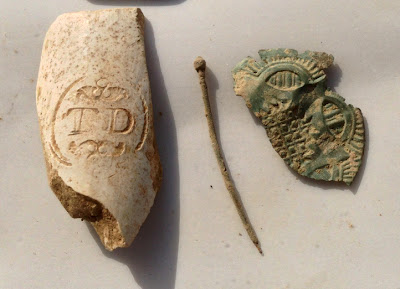Just a few of things we have dug our of the ground lately. Above, most of a porringer made of Staffordshire comb and dot slipware, ca. 1750. There were other sherds of this vessel in nearby units, so we think we have pretty much the whole thing.
Some small finds: metal bead, buttons, cufflinks.
Pipe bowl with maker's mark, pin, fragment of ornamental brass.
Coin weights, used to detect counterfeit or clipped coins.
A hand-wrought nail. Until 1790, nails were made one at a time by blacksmiths, so they were not cheap and builders used wooden pegs whenever they could. After that the nail-making machine was introduced, which eventually made them much cheaper. You can tell the difference because a hand-wrought nail tapers on all four sides, whereas a cut nail is a wedge cut out of a bar, and so tapers on only two. A well-preserved hand-wrought nail also shows the individual hammer blows that shaped the head; however, you sometimes find a hand-wrought head on a machine-cut shaft, so the shaft is a better guide.
And a pile of potsherds, mainly coarse earthenware, from one level of one 3x3-foot unit in our trash midden. These sherds come from milk pans and storage jars.
Friday, December 7, 2012
Subscribe to:
Post Comments (Atom)








No comments:
Post a Comment